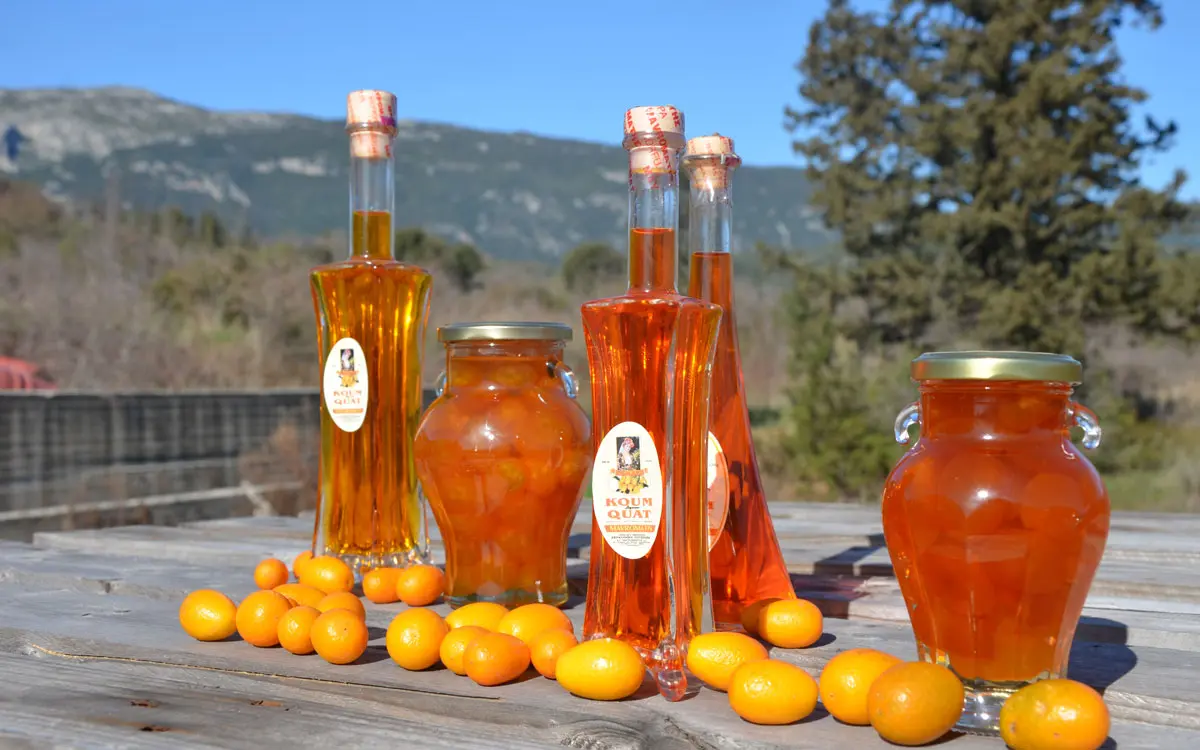The kumquat of Corfu is undoubtedly one of the island’s most iconic local products and has become inextricably linked with its identity. Its presence in the Ionian Islands is not self-evident, as this is a plant with no Mediterranean origin. The kumquat (Citrus japonica) comes from the Far East, specifically from China, where it was cultivated since antiquity. Its name in Chinese means “golden orange,” and it is considered a symbol of good luck, health, and prosperity. It belongs to the citrus family, but unlike common oranges or lemons, it stands out for its small size, slightly oval or cylindrical shape, sweet peel, and characteristically bittersweet flesh.
The history of the kumquat’s establishment in Corfu begins in the early 20th century, around 1924, when the British agronomist and diplomat Sidney Merlin introduced the plant from Asia. Merlin was already known in Greece for introducing and adapting the orange variety that bears his name (“Merlin orange”), and his contribution to the dissemination of new citrus fruits was significant. The kumquat, however, had a unique trajectory: its cultivation did not spread nationwide but took root exclusively, or almost exclusively, in Corfu, where it found ideal microclimatic conditions and soil composition to grow.
Corfu, with its increased humidity, mild winter cold, and well-drained soils, offered the perfect environment for the plant’s cultivation. The first plantings were made in the northern plains of Corfu and gradually expanded to other areas, mainly in the north and west. Despite limited production, the kumquat experienced remarkable commercial success, as the processing of the fruit breathed new life into the island’s gastronomic and touristic identity.
The fresh kumquat fruit, due to the acidity of its flesh and its intense aroma, is not widely consumed raw, although some choose to eat it whole to experience the sweetness of the peel in contrast with the bitterness of the interior. The great value of the kumquat lies in its exceptional suitability for processing. Thus, from the mid-20th century, a small but dynamic artisanal production of kumquat products began to develop in Corfu, with pioneering cottage industries laying the foundations for today’s sector.
The most widespread product is undoubtedly kumquat liqueur, a beverage with a strong aroma and an orange-yellow or amber color (depending on processing and aging duration). It has a bittersweet flavor, aromatic intensity, and can be consumed neat, with ice, or used as a base for cocktails. This liqueur has become a trademark of the island, offered almost everywhere, from tourist shops to hotels and restaurants.
In addition to the liqueur, Corfu produces a variety of other kumquat-based products: spoon sweets, which stand out for the balance between the bitter taste and the sweet syrup; strongly flavored jams with an exceptional aftertaste; syrups; even dried kumquats or ones dipped in chocolate. The fruit’s distinctive taste has also inspired younger producers and chefs to incorporate it into modern recipes: from sauces for game or pork to desserts based on yogurt or mastiha, and high-end pastry creations.
The dynamism of kumquat as a local product has been officially recognized through the awarding of the Protected Geographical Indication (PGI) label, a fact that enhances its reputation in markets within and outside Greece and secures its authenticity. Today, production remains limited but of high quality. Most of the quantities are consumed in Greece, though a significant portion is exported, mainly to European countries such as Germany, Italy, and the United Kingdom, where there are Greek communities or growing interest in Greek gourmet products.
The economic significance of kumquat is not negligible for the local community. Small businesses and family-run units are involved in the processing and distribution of the products, creating a stable production network closely tied to tourism. Visitors to the island have the opportunity to visit small production facilities, see the production process up close, and taste the products within an authentic experience framework.
The cultural dimension of kumquat is equally important. The plant has become part of Corfu’s daily life not only as a commercial good but also as a symbol of hospitality and tradition. There are many cases where the kumquat adorns yards and gardens as an ornamental plant, with its fruits traditionally offered to guests. It is, therefore, not just an element of culinary culture but also of Corfu’s social life.
Today, Corfu’s kumquat stands at a crossroads of renewal and extroversion. New generations of producers are investing in more sustainable cultivation practices, innovative promotion methods, and international partnerships aiming at the export of high-quality products. The challenge is to preserve the authenticity of the fruit and its derivatives without sacrificing traditional flavor to the demands of mass production.






Comments are closed